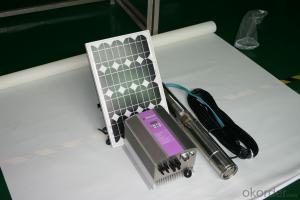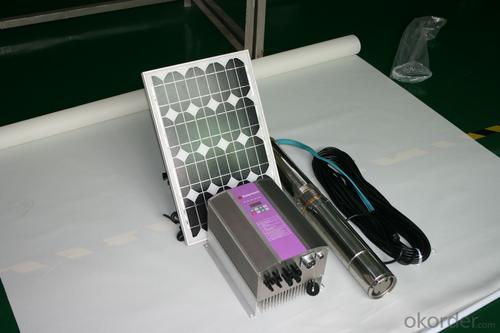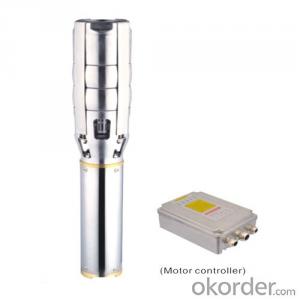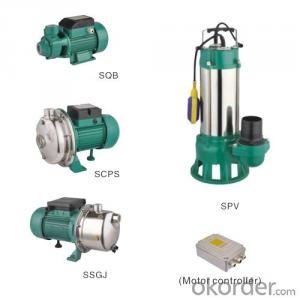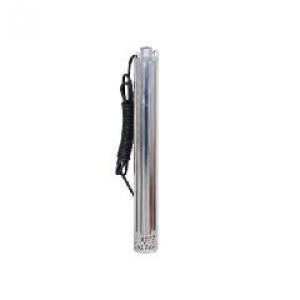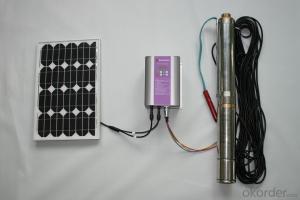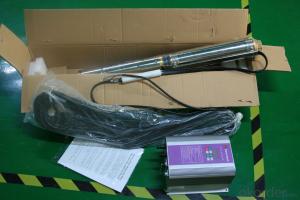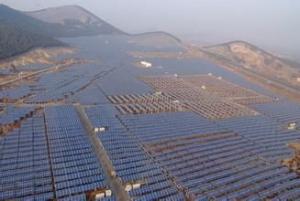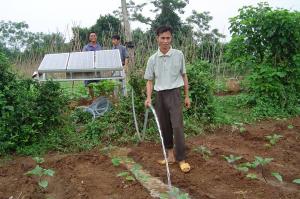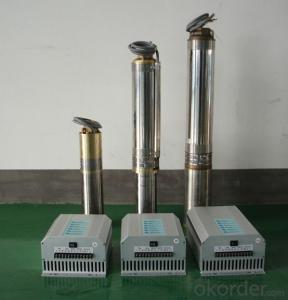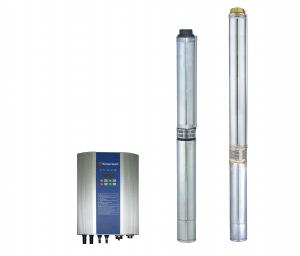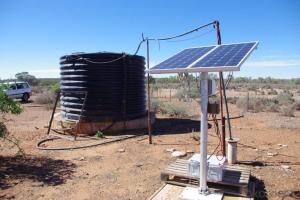Sf2 Solar Pump Ac Solar Pumping Systems
- Loading Port:
- Shekou
- Payment Terms:
- TT OR LC
- Min Order Qty:
- -
- Supply Capability:
- 100000000000000000000 /month
OKorder Service Pledge
OKorder Financial Service
You Might Also Like
Products
Solar Pumping System supplied by Shenzhen Solartech Renewable Energy Company(manufacturer) can be applied to daily use (ground water), agricultural irrigation, forestry irrigation, desert control, pasture animal husbandry, water supply for islands, wastewater treatment engineering, and so on. Solartech” Solar water pump System is dispensed with energy storing devices, and stores water instead of electricity. It improves the reliability of the device, at the same time, it lowers the construction and maintenance costs of the irrigation system dramatically.
In recent years, with the promotion of the utilization of new energy resources, Solar Pumping System is more and more used in municipal engineering, city centre squares, parks, tourist sites, resorts and hotels, the landscapes and fountain irrigation systems in the residential areas.
Technical Features
Optimization of Single Pump System
A single solar irrigation system consists of only one pump, a power -matched solar array and an inverter . The aim of optimization is to reduce the amount of PV modules as much as possible on the premise of filling the requirement of head and capacity. The rotational speed of pump is regulated according to the irradiation on the solar array; when the sunlight reaches its peak, the pump runs at the rated speed, and the output approaches the peak power of the solar array; when the sunlight is less abundant, the speed of pump varies bellow the range of the rated speed; when the speed as low as the capacity becomes zero, the solar pumping system stops working. So, there are big differences between solar irriation systems and traditional pumping systems in system design, and the system should be optimized according to the requirements of head, capacity, and local conditions of sunlight.
•Determine the optimal average daily operating time and the range of speed governing.
•Choose the optimal head and capacity of the pump.
•Determine the maximum power of PV modules, the best working voltage and method of connection.
Optimization of Multi-pump Systems:
There are several pumps in a multi-pump system. The pumps can be driven either by only one high-power inverter, or by several matching inverters. In the case of large capacity demand, the operation of the multi-pump system is more flexible. By switching solar arrays and pumps, all of the pumps run in MPPT mode when the sunlight is abundant, while some pumps will be shut down and all solar arrays supply power intensively for the rest running pumps when irradiation is weak. Based on the optimization of single pump system, the range of speed can be further optimized, and the photovoltaic(PV) pumping system always works with high efficiency.
Product Specifications
Model | Rated Power ( kW ) | Rated Voltage ( V ) | Head ( M ) | Daily Flow ( ㎥/ D ) |
PS370 | 0.37 | 220 | 20-47 | 20-1 |
PS550 | 0.55 | 220 | 15-70 | 40-1 |
PS750 | 0.75 | 220 | 6-81 | 100-1 |
PS1100 | 1.1 | 220 | 8-93 | 100-1 |
PS1500 | 1.5 | 220 | 7-128 | 130-1 |
PS2200 | 2.2 | 380 | 12-163 | 130-1 |
PS3000 | 3 | 380 | 9-187 | 250-10 |
PS4000 | 4 | 380 | 6-225 | 500-10 |
PS5500 | 5.5 | 380 | 10-172 | 500-20 |
PS7500 | 7.5 | 380 | 15-237 | 500-20 |
PS9200 | 9.2 | 380 | 20-140 | 500-40 |
PS11000 | 11 | 380 | 23-159 | 500-40 |
PS13000 | 13 | 380 | 27-189 | 500-40 |
PS15000 | 15 | 380 | 31-208 | 500-40 |
PS18500 | 18.5 | 380 | 39-143 | 500-100 |
PS22000 | 22 | 380 | 25-86 | 700-210 |
PS26000 | 26 | 380 | 30-105 | 700-210 |
PS30000 | 30 | 380 | 35-125 | 700-210 |
PS37000 | 37 | 380 | 40-150 | 700-210 |
PS45000 | 45 | 380 | 50-180 | 700-210 |
PS55000 | 55 | 380 | 65-200 | 700-210 |
- Q: What is a photovoltaic pump?
- Advantages of photovoltaic power (1) Reliable: PV power rarely used in moving parts, reliable. (2) safe, no noise, no other pollution. Do not produce any solid, liquid and gas harmful substances, absolutely environmentally friendly. (3) installation and maintenance is simple, low operating costs, suitable for unattended and so on. Especially for its high reliability and concern. (4) good compatibility, photovoltaic power generation can be used in conjunction with other energy, you can also need to make the PV system is easy to capacity. (5) a high degree of standardization, the series can be connected in parallel to meet the needs of different electricity, versatility. (6) solar energy everywhere, a wide range of applications.
- Q: Can solar pumps be used for water supply in educational institutions or universities?
- Yes, solar pumps can certainly be used for water supply in educational institutions or universities. Solar pumps are a sustainable and renewable solution that can provide a reliable and cost-effective water supply. They can be utilized for various purposes such as irrigation, drinking water supply, and even wastewater management. With the increasing emphasis on sustainability and green initiatives, solar pumps offer an excellent option for educational institutions and universities to meet their water supply needs while reducing their carbon footprint.
- Q: Can a solar pump be used for desalination?
- Yes, a solar pump can be used for desalination. Desalination is the process of removing salt and other impurities from seawater to make it suitable for consumption or irrigation. Solar pumps are powered by solar energy, which makes them a sustainable and environmentally friendly option for desalination projects. Solar pumps can be used to draw water from the sea or any other source and supply it to a desalination plant, where the water is treated and purified. The solar pump provides the necessary energy to drive the desalination process, reducing the reliance on fossil fuels and minimizing the carbon footprint of the desalination project. Additionally, using solar pumps for desalination can make it more feasible and cost-effective to implement such projects in remote or off-grid areas where access to electricity may be limited. Overall, solar pumps offer a viable and sustainable solution for powering desalination processes.
- Q: Are there any compatibility issues with integrating a solar pump into an existing water system?
- Yes, there can be compatibility issues when integrating a solar pump into an existing water system. Factors such as the size and capacity of the existing system, voltage requirements, and flow rates need to be considered to ensure proper integration. Additionally, compatibility with control systems, wiring, and water quality requirements should also be evaluated. It is important to consult with experts or professionals to assess any potential compatibility issues before integrating a solar pump into an existing water system.
- Q: Are there any limitations on the maximum height or elevation that a solar pump can pump water?
- Yes, there are limitations on the maximum height or elevation that a solar pump can pump water. The pump's maximum pumping height is determined by factors such as the power of the solar panels, the efficiency of the pump, and the atmospheric pressure. Typically, solar pumps can lift water to a maximum height of around 100-200 meters, but this can vary depending on the specific model and setup.
- Q: Can a solar pump be used for water supply in a community center?
- Yes, a solar pump can be used for water supply in a community center. Solar pumps utilize solar energy to power the pumping mechanism, making them a sustainable and cost-effective solution for water supply in areas where electricity is not readily available. They can provide a reliable source of water for various purposes, including drinking, sanitation, and irrigation, making them suitable for community centers.
- Q: How do solar pumps handle fluctuations in voltage or power supply?
- Solar pumps are designed to handle fluctuations in voltage or power supply efficiently. They typically have built-in voltage regulators that stabilize the power input, ensuring a consistent and reliable operation. Moreover, solar pumps utilize direct current (DC) motors, which are more tolerant to voltage fluctuations compared to alternating current (AC) motors. This allows them to continue functioning effectively even if there are minor variations in the power supply.
- Q: What is the maximum operating temperature for a solar pump?
- The maximum operating temperature for a solar pump typically depends on the specific model and manufacturer. However, most solar pumps can operate efficiently at temperatures ranging from 40 to 60 degrees Celsius (104 to 140 degrees Fahrenheit). It is essential to consult the product specifications provided by the manufacturer for accurate information regarding the maximum operating temperature of a particular solar pump.
- Q: Can a solar pump be used for irrigation?
- Yes, a solar pump can be used for irrigation. Solar pumps are capable of utilizing solar energy to power water pumps, allowing for efficient and sustainable irrigation systems. These pumps can provide a reliable source of water for agricultural purposes, reducing the dependency on traditional energy sources and minimizing environmental impact.
- Q: Can a solar pump be used for swimming pool heating?
- Yes, a solar pump can be used for swimming pool heating. Solar pumps use energy from the sun to circulate water in the pool, helping to heat it up. They are a cost-effective and environmentally friendly option for pool heating. By using solar power, you can reduce your dependence on electricity or gas, saving energy and money in the long run. Additionally, solar pumps require little maintenance and are easy to install. However, it's important to note that the effectiveness of the solar pump in heating the pool will depend on various factors such as the size of the pool, the location, and the amount of sunlight available.
Send your message to us
Sf2 Solar Pump Ac Solar Pumping Systems
- Loading Port:
- Shekou
- Payment Terms:
- TT OR LC
- Min Order Qty:
- -
- Supply Capability:
- 100000000000000000000 /month
OKorder Service Pledge
OKorder Financial Service
Similar products
Hot products
Hot Searches
Related keywords
